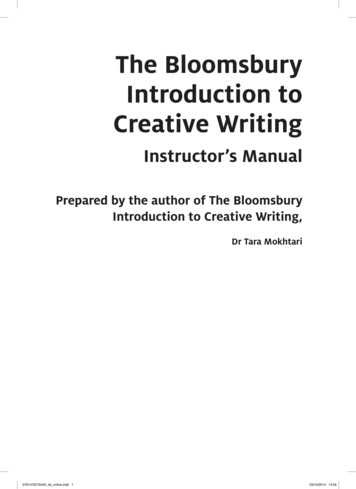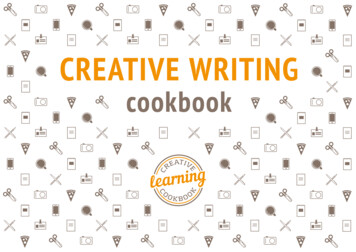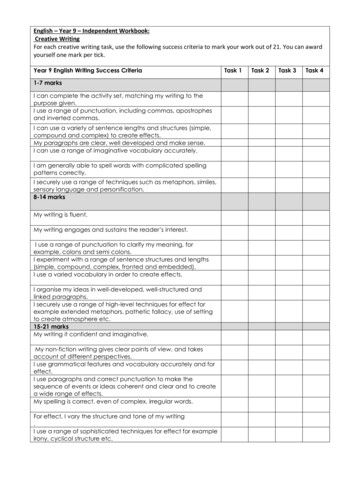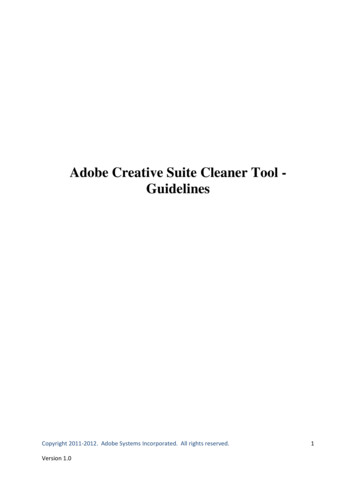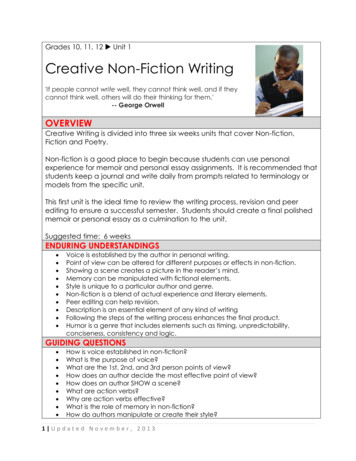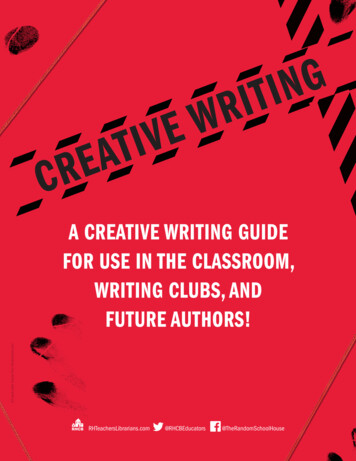
Transcription
ERCEVITAIRWGNITArt used under license from Shutterstock.comA CREATIVE WRITING GUIDEFOR USE IN THE CLASSROOM,WRITING CLUBS, ANDFUTURE RandomSchoolHouse
YOUNG ADULT NOVELS FOR CREATIVE WRITING LESSONSEnglish teacher Kim Herzog on why young adult literature works well for creative writing units and lessons:“Everyone has a story to tell. Sometimes the hardest part of writing, especially for students, is figuring out how to get stories onthe page. Through my years of teaching, I have found that nothing is more powerful for young writers than a strong model—one thatshowcases structure, craft, and style in various ways to enable and empower students’ creativity. Often writers struggle with whereto begin; for that reason, writing prompts can be invaluable. Selections of passages from these model texts can be used to createwriting exercises in small and large groups alike, whether in the classroom or a writing group or club. Young adult novels provide greatintroductions to creative writing, with accessible text, engaging storylines, and many examples of the different techniques and craftsused in creative writing.”In A Good Girl’s Guide to Murder by Holly Jackson, teachers and student writers will find myriad opportunities for exploring creativewriting. This guide can be used independently or by an instructor to help both long and short forms of writing.A FEW WAYS TO USE YOUNG ADULT NOVELS FOR CREATIVE WRITING!In this guide, we’ve given a variety of writing lessons—mini-lessons, mirror lessons, and full-piece prompts—using Holly Jackson’sA Good Girl’s Guide to Murder. We’ve highlighted structurally interesting young adult novels and provided suggested discussionquestions to help writers think about the effects of each technique or device, and we’ve suggested, organized by genre, incredibleyoung adult novels for writers to read and learn from for their own stories and writing.MINI-LESSONSMIRROR LESSONSArt usedArtunderusedlicenseunder fromlicenseShutterstock.comfrom Shutterstock.comABOUT THE BOOKEveryone in Fairview knows the story. Pretty and popular high schoolsenior Andie Bell was murdered by her boyfriend, Sal Singh, who thenkilled himself. It was all anyone could talk about. And five years later,Pip sees how the tragedy still haunts her town. But she can’t shake thefeeling that there was more to what happened that day. She knew Salwhen she was a child, and he was always so kind to her. How couldhe possibly have been a killer? Now a senior herself, Pip decides toreexamine the closed case for her final project, at first just to castdoubt on the original investigation. But soon she discovers a trail ofdark secrets that might actually prove Sal innocent . . . and the linebetween past and present begins to blur. Someone in Fairview doesn’twant Pip digging around for answers, and now her own life might bein danger. This is the story of an investigation turned obsession, full oftwists and turns and with an ending you’ll never expect.FULL-PIECE PROMPTS
MINI-LESSONS: These warm-ups are to help get your creativity going. They are short, craft-based activities(five to ten minutes long) that can potentially lead to longer pieces! Think of them as small writing exercises.1. Chapter one begins with the following two sentences:“Pip knew where they lived. Everyone in Fairview knewwhere they lived.” (p. 3) In this example, Holly Jacksonhas intentionally chosen to avoid revealing who “they” are.Omitting vital information piques readers’ curiosity, andthere is more than one way to omit information. For yourwriting warm-up, write the next three to five sentences.Don’t divulge who “they” are; instead, hint at it by describingwhere Pip can find “them.”6. Often in dialogue, we resort to saying “he said” or “she said”2. In creative writing, titles are important. The title of A GoodGirl’s Guide to Murder has a few craft elements: there isalliteration (the repetition of a sound) as well as allusion(to other works with similar titles, in this case). To preparefor titling your own works, take a chapter from A Good Girl’sGuide to Murder and create a title for it, using alliterationand alluding to something in pop culture while alsoreferencing the content of the chapter.she whispered” is different from “‘I still love you,’ she howled.”4. Try using thought-provoking redactions to hide informationfrom your readers. This is a great way to pace the release ofinformation; by giving readers some clues but not the fullpicture, we whet their appetites without overwhelming them.How do you think Jackson decides which information toredact? See pages 130 to 136 for an example. Outside themystery and thriller genres, how would this techniquebe useful?5. In Pip’s Capstone Log on page 127, she begins to usethe pronoun “our”: “If Daniel is our killer, he might havedisturbed the investigation somehow in his capacity as apolice officer.” By doing this, she has included others in hersearch, making it seem accessible to the reader. Explore theways shifting pronouns can be used to reframe stories.reader important information about the speaker and what isbeing said. Here is an example: “‘And there are still too manyyouths loitering in the park in the evenings,’ anold woman croaked, her arm raised beside her head.”(p. 281) Write the same piece of dialogue three times,using different tags. Focus on changing the mood of thedialogue with the chosen verb. For example, “‘I still love you,’7. Pip tries to decipher notes left by Andie in her assignmentpad to reconstruct what happened before her death. Thereare notes like: “TS @ 7:30” or “IV @ 8” on pages 206 and207. Try to create a similar mystery in your writing, usingcodes or puzzles, and have your character think throughwhat the solution might be, providing multiple options forboth your character and your reader.8. Anaphora is the repetition of a word or phrase at thebeginning of clauses that follow each other, and can beused to emphasize a point. In this example, the repetitionof where highlights Andie’s absence and how her loss willbe an everyday reality for her mother: “[Dawn Bell] didn’thave her daughter, but she still had the place where she’dslept, where she’d woken, where she’d dressed, where she’dscreamed and shouted and slammed the door, where hermom had whispered good night and turned off the light.” (p.199) Try using anaphora in your writing for a powerful wayto draw attention to something.9. A cliff-hanger compels a reader to keep reading, and is apowerful tool in creative writing, no matter the length of thestory. For instance, look at this cliff-hanger: “When you askpeople in town what happened to Andie Bell, they’ll tell youwithout hesitation: She was murdered by Salil Singh. No‘allegedly,’ no ‘might have,’ no ‘probably,’ no ‘most likely.’ Hedid it, they say. Sal Singh killed Andie. But I’m just not sosure.” (p. 19) The final line makes readers want to know whyPip isn’t sure, and compels them to continue reading. Trywriting a story that ends with the line “But I’m just not sosure” to achieve the same effect.Art used under licenseArt usedfromunderShutterstock.comlicense from Shutterstock.com3. Rhetorical questions can be a great way to reveal acharacter’s thoughts without explicitly saying “she thought.”For this warm-up, imagine a character who just got in afight with their best friend. Use rhetorical questions, asJackson does on page 104, to reveal one of the characters’reactions to the fight, their thoughts about why it happened,and what their next steps might be.to attribute speech. But using more specific verbs can give the
MIRROR LESSONS: These lessons are based on the majorparts of a story: plot, character, description, setting,dialogue, and theme, and will help writers to establishtheir own voices. These can be used together to build aframework for a larger story.PLOTFreytag’s Pyramid is a useful device for planning a story. Begin bymapping out the major plot points of a chapter of your choice,using the elements of the pyramid. For this activity, the “resolution”will be the concluding action or event of the chapter rather thanthe end of the book (as that would take a much bigger pyramid!).(p. 180) In this passage, we don’t just see this character—wehear him, smell him, and get a glimpse at his behaviors, too,all in a few sentences. With this introduction as inspiration, usespecific details in your writing as you introduce your readers to acharacter in your piece, allowing the character to become threedimensional by providing robust descriptions.DIALOGUERather than writing conventional dialogue, try something new inyour writing by having characters converse in one of the followingways, as Holly Jackson does in her text. Interviews onDenouementOnce you have had some practice, use the pyramid to map outyour next story before you begin writing. This will help you avoidgetting stuck or spending too much time on a plot point.SETTINGThe book begins with a description of the Singh house asperceived by the Fairview residents, and more specifically, theadolescents of the town. There is a sense of time and placecreated by details, as well as a simile comparing the house toa haunted house.Choose a setting in a story you’re working on—a playground,a school, a house, or even a parking lot. Using descriptionsassociated with all five senses as well as a creative simile,depict this setting in a paragraph, doing your best to avoidexplicitly describing something; for instance, instead of saying“the swings sounded rusty,” you can say “the rusted swingscreaked in the breeze.”Art used under license fromArt usedShutterstock.comunder license from Shutterstock.com TextsCHARACTER DESCRIPTIONFirst impressions are crucial when it comes to understandinga character. For example, review the first impression Jacksonprovides of Howie, the drug dealer: “They heard shuffling andcoughing from inside. A few seconds later the door was roughlypulled open. Howie stood there, blinking at them. He’d takenoff his coat now and was wearing a stained blue T-shirt, his feetbare. He smelled of stale smoke and damp, moldy clothes.”A theme is a central topic or idea. These recurring ideas canbe seen throughout a text. Although they are never explicitlystated, when reading a book, we understand the book’s themeor message.First, determine a major theme in A Good Girl’s Guide to Murder.Then use this theme to guide your writing. How can you revealthis theme without explicitly naming it? Determine the majorrecurring idea or theme of your piece, and use that as a frame toget started (rather than starting with setting or character). Howdoes this change the way your piece comes together?PERSPECTIVEShift the perspective of A Good Girl’s Guide to Murder by retellinga chapter from a different character’s point of view. For instance,tell a chapter from the perspective of one of the characters inPip’s Persons of Interest web on page 261.FULL PIECEA Good Girl’s Guide to Murder is epistolary, which means ituses letters to tell its story. It also uses clips from interviews,transcripts, emails, and logs within the narrative. For a full shortstory, integrate at least two alternative styles of writing into yournarrative. Here are some examples: Text chains Emails Interviews Letters Webbing Newspaper clippings
Twists, games, and MORE twists:Structurally interesting YA, perfect for writing inspirationThese shifty young adult novels will help writers analyze the many effects that techniques can have on the reader.STRUCTURALLY INTERESTING: One of Us Is Lying and One of Us Is Next usemultiple perspectives, and the reader follows each character as they uncover plotsand secrets, eventually weaving it all into one cohesive narrative.1. One of Us Is Lying has been described as Pretty Little Liars meets The BreakfastClub. Fiction writers are always borrowing from their predecessors. What is it thatmakes this kind of conflict universal? Why does it continue to be relatable andentertaining?2. What effect do the multiple perspectives have on each story? Is it always thesame? What is the added value of using different voices to tell one story?3. One of Us Is Lying and One of Us Is Next both include psychological manipulation and mind games. What other books thatyou’ve read employ this? How does universality affect the reader?STRUCTURALLY INTERESTING: told in two voices, one prose and one poetry.1. There’s a twist beneath a mystery in this book. Looking back, how are the pieces of the twist layeredinto the narrative? Did you see the final twist coming?2. Isobel Catching’s narrative shifts in tone and form. Why do you think her chapters were written inverse? How does this affect your understanding of her story?STRUCTURALLY INTERESTING: John Green describes We Were Liars as “blisteringly smart . . . utterlyunforgettable” because of the TWIST!1. Discuss the significance of the title, We Were Liars. In what ways does it accurately describe the eventsand relationships portrayed in the novel?2. About that ending: Was it a surprise, or did you see it coming? Return to earlier passages in the bookand locate instances of foreshadowing. How did Lockhart accomplish this without giving anythingaway? Do you think she was successful? Why or why not?3. W e Were Liars is a first-person narrative, but that narrative includes fairy-tale interstitials, hallucinatoryepisodes, and scenes that are repeated with new interpretations at different points in the story. Arethere other books you’ve read that have a similar structure or that utilize similar devices and methods?Art used under licenseArt usedfromunderShutterstock.comlicense from Shutterstock.com3. T here are a lot of discussions about life after death in this story. How does it differ from other booksthat address this topic? How do Beth’s and Isobel’s experiences and opinions evolve throughout?How is this reflected in the novel’s structure?
YOUNG ADULT TITLES THAT AREEXCEPTIONAL CRAFT EXAMPLESThe following young adult titles exemplify particular crafts or devices and are excellent modelsfor aspiring writers to read and learn from.CONTEMPORARY FICTIONLimited TimelineAlternatingPoint of ViewElements of TheaterVignettes andDiary EntriesAlternating TimelineEpistolaryReverse TimelinePersonificationTime WarpMagical RealismInspired byActual EventsElementsof TheaterSuperheroArt used under license from Shutterstock.comANTHOLOGIES AND SHORT STORIESCollection of Storiesabout a PlaceJewish CenteredStoriesThematic Connectionof StoriesAnthology ofMultiple FormsThematic Connectionof Stories
HISTORICAL ine music, text,and illustrationAllegorySCIENCE FICTION & FANTASYThematic Connectionof phyUpdated ClassicGraphic Novel Hero’s JourneyLiterary MagicalRealismALTERNATIVE HISTORY/RETELLINGSBiography andAutobiographyAlternative AmericanHistoryAlternative CharacterPerspectiveRevised ArthurianLegend!STORY STARTERSUpdated Shakespeare!ImaginativeSentence StartersPart Writing Guide,Part MemoirFairy Tale RetellingArt used under license from Shutterstock.comAllegory
JOIN THEWRITING COMMUNITY!WHAT IS IT?A free, safe space for writers to create & share!HOW TO GET INVOLVED?Customize a profile with a bio, bookshelf, interests, and moreCreate and share original stories and poetry(over 5,000 published stories!)Read and discuss writing with fellow members(over 30,000 members!)Comment and react to articles and stories, includingbehind the scenes author videosGet curated content delivered to a personal dashboardbased on your interestsBONUSFollow authors and writers, and be a partof this incredible writing community!To learn more about how to get your studentsand writers involved, visit GetUnderlined.com
introductions to creative writing, with accessible text, engaging storylines, and many examples of the different techniques and crafts used in creative writing.” In A Good Girl’s Guide to Murder b

